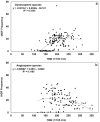Intra-annual density fluctuations in tree rings are proxies of air temperature across Europe
- PMID: 37516810
- PMCID: PMC10387074
- DOI: 10.1038/s41598-023-39610-8
Intra-annual density fluctuations in tree rings are proxies of air temperature across Europe
Abstract
Intra-Annual Density Fluctuations (IADFs) are an important wood functional trait that determine trees' ability to adapt to climatic changes. Here, we use a large tree-ring database of 11 species from 89 sites across eight European countries, covering a climatic gradient from the Mediterranean to northern Europe, to analyze how climate variations drive IADF formation. We found that IADF occurrence increases nonlinearly with ring width in both gymnosperms and angiosperms and decreases with altitude and age. Recently recorded higher mean annual temperatures facilitate the formation of IADFs in almost all the studied species. Precipitation plays a significant role in inducing IADFs in species that exhibit drought tolerance capability, and a growth pattern known as bimodal growth. Our findings suggest that species with bimodal growth patterns growing in western and southern Europe will form IADFs more frequently, as an adaptation to increasing temperatures and droughts.
© 2023. The Author(s).
Conflict of interest statement
The authors declare no competing interests.
Figures






References
-
- Fritts HC. Tree rings and climate. Sci. Am. 1972;226:92–100. doi: 10.1038/scientificamerican0572-92. - DOI
-
- Balzano A, Battipaglia G, De Micco V. Wood-trait analysis to understand climatic factors triggering intra-annual density-fluctuations in co-occurring mediterranean trees. IAWA J. 2019 doi: 10.1163/22941932-40190220. - DOI
-
- Sass U, Killmann W, Eckstein D. Wood formation in two species of Dipterocarpaceae in Peninsular Malaysia. IAWA J. 1995;16:371–384. doi: 10.1163/22941932-90001427. - DOI
-
- Evert RF, Eichhorn SE. Esau’s Plant Anatomy: Meristems, Cells, and Tissues of the Plant Body: Their Structure, Function, and Development. 3. Willey; 2006.
-
- Zuidema PA, et al. Tropical tree growth driven by dry-season climate variability. Nat. Geosci. 2022;15:269–276. doi: 10.1038/s41561-022-00911-8. - DOI
Publication types
MeSH terms
LinkOut - more resources
Full Text Sources

